|
The time has come when it is opportune to take stock of the present position in television, and in this article we endeavour to present our readers with a picture in proper perspective of the present state of development, with a discussion on limitations of existing systems and the possibilities which lie ahead as a result of recent laboratory progress.
The Present Stage of Progress
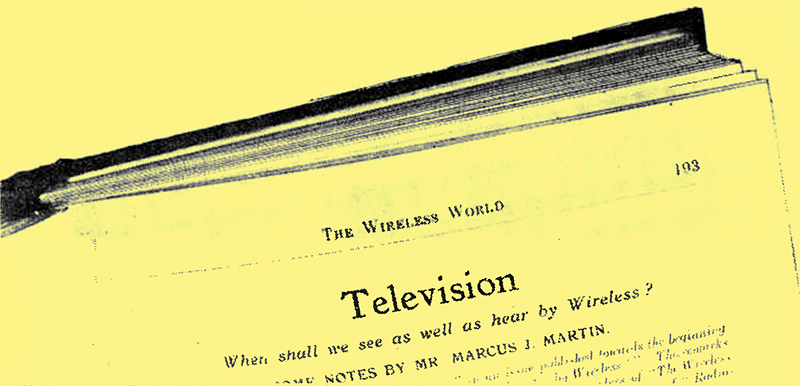
How long ago The Wireless World began to take an interest in the possibilities of television is indicated by this reproduction of the heading of an article which appeared in an issue dated June, 1915.
The art of television is one of many examples in which invention has outstripped achievement. A glance through the literature of the subject is sufficient to show that practically all of the basic methods of transmitting optical images by electrical means are old in conception, though it is only in recent years that success of a practical kind has been attained. The situation in this respect is somewhat analogous to that of radio telephony, the advent of which was delayed until the means of obtaining practical results became available in the shape of the thermionic valve, but the technical difficulties in the case of television are so much greater that the solution of the problem, in terms of communication or entertainment value, is even now barely being approached.
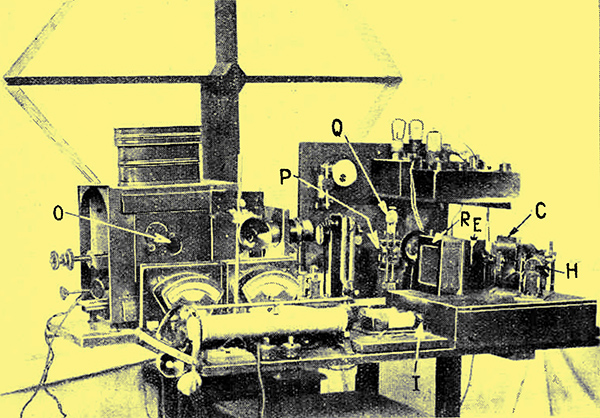
An early worker in the field of television was a young Hungarian engineer, Mihaly, a description of whose first practical efforts was included in The Wireless World of March 26, 1924. This photograph appeared in that issue to illustrate some of his apparatus.
In one sense the present situation is highly favourable to the development of television in a practical form. The public are accustomed to a broadcasting service and are looking forward, perhaps with greater certainty than is justified, to an early date when sight of the same degree of perfection as sound will form a normal part of broadcast transmissions. The enterprise and energy of the Baird Company has led to a service of broadcast television which, at any rate, has whetted the appetites of those who have received the transmissions, and has proved once more how adaptable are the human faculties to relatively imperfect presentations of the original subject matter. The BBC are also fully alive to the possibilities of television, and the skill with which they have made the most of the limitations of the medium in the present transmissions has completely justified the inauguration of a regular service of the present character.
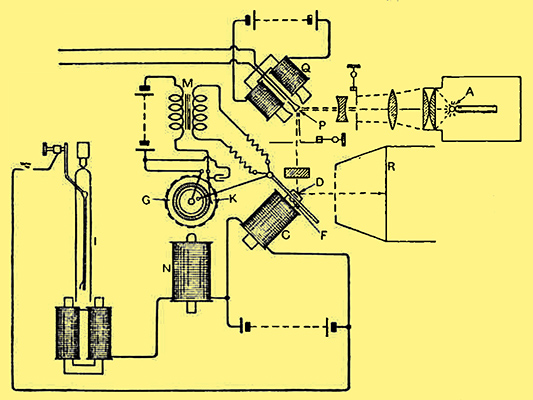
The receiver circuit employed by Mihaly.
Having regard to the future of television, we may thus say that there is at the present moment an attitude of expectancy on the part of the public, who consider that the solution is merely a matter of time, and, while this is in itself a stimulus to invention and commercial enterprise, it may also constitute a danger in the measure in which the existing optimism is not warranted by the facts. It is not sufficient to say that high quality television is bound to come, and that it is only a matter of logical development before the television screen becomes as common an object in the home as is the loud speaker at the present date. We must examine the technical justification for such a proposition and face the basic difficulties inherent in the problem, and then, and then only, will we be able to form an estimate as to how much we may reasonably expect.
How Sight Differs from Sound Broadcasting
It is perhaps opportune at this juncture to consider the essential difference between the broadcasting of sight and sound, namely, the fact that a visible subject has to be analysed into elements which are successively transmitted as modulations of the carrier wave, and, after reception, synthesised so as to give back again a representation of the original. It is unnecessary to labour this point, which is probably familiar to all readers of The Wireless World. A satisfactory analogy is that of a page of a book, which can either be regarded as a visible object, i.e., synthetically, or as a succession of letters, i.e., analytically. The eye, in reading the book, is carrying out practically the same function as the scanning apparatus in the television transmitter; when it reaches the end of one line it starts at the beginning of the next, and so on until the end of the page is reached, after which the next succeeding page is started, and so on. For the purpose of this illustration we have to imagine the eye as apprehending only one element at a time, i.e., one letter, and, whereas in the case of a book the difference between the various elements lies in the difference between one letter and another, in the case of television the electrical 'eye' takes in the intensity of the light at any point of its sweep across the visible object being scanned.
The process of transmitting visible subject matter over a radio or other communication channel consists in generating electrical impulses front each 'line' of the image which is being analysed and transmitting them in sequence over the channel just as they occur. Pursuing our b book analogy, we may imagine the letters of the book in each line to he set up on a continuous tape, as in a system of printing telegraphy, and caused to generate electrical impulses. If these are received at a distance they may he reconverted into a succession of letters which are then rearranged in the exact manner in which they originally occurred before transmission.
Synchronising
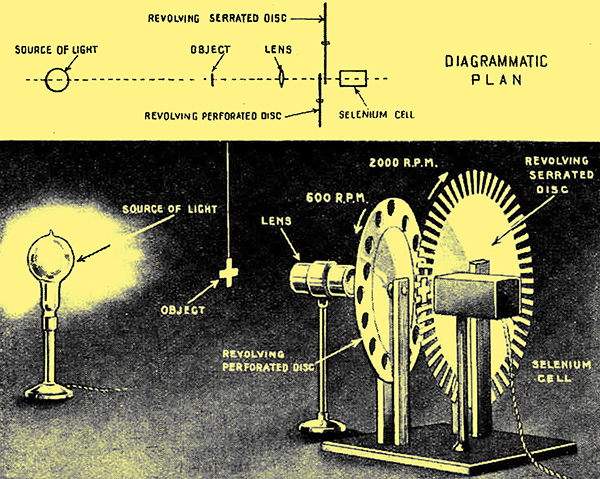
A drawing which was included in an article in the issue of The Wireless World, of May 7, 1924, to explain the principles of the early apparatus used by Baird for the transmission of shadow pictures.
It is not proposed in the present article to go into any detail at all regarding the various manners in which scanning, as it is called, can be carried out. Our feature is common to all methods, and that is the use of synchronised apparatus at the transmitting and receiving ends. The need for this will be understood from the book analogy; if we imagine the lines of the book to he successively scanned at the transmitter and impulses to he sent over the communication channel corresponding to every letter of each line, it is necessary, for the immediate reconstruction of the printed page, to have some apparatus at the receiving end which will set up the successive letters in their appropriate positions. The simplest way to carry out this process is to have the scanning system at the transmitter moving exactly in step with a corresponding system at the receiver. The former system will thus he 'looking' at a letter when the latter is 'pointing' to the blank part of the page where the letter has to go. If then a signal is sent down the channel which indicates that the letter is required, it will automatically be set up in the right place.
Considering then the actual process of television, we may say that the transmitter embodies an electrical 'eye' which systematically 'looks' at each successive element of the image to he transmitted, and the receiver embodies synchronised apparatus which is arranged to 'point' in a direction exactly corresponding to the picture clement at which the transmitter is 'looking' at any instant. The intensity of the light falling on the electrical 'eye' causes a signal to be sent which regulates the illumination at the spot at which the receiver is pointing, and in this manner the picture is built up. It is necessary that this process of scanning should be repeated in such a manner that the image is perceived by the eye as continuous, but in this respect the requirements are not mutually more exacting than those of a cinema film, though the duration of the illumination of any point is momentary in a television system and therefore much shorter than in the film case. It is important, however, to decide what frequency of repetition is necessary for practical television, as this constitutes one of the limitations upon the perfection which can be obtained in the final result.
Methods of Coding
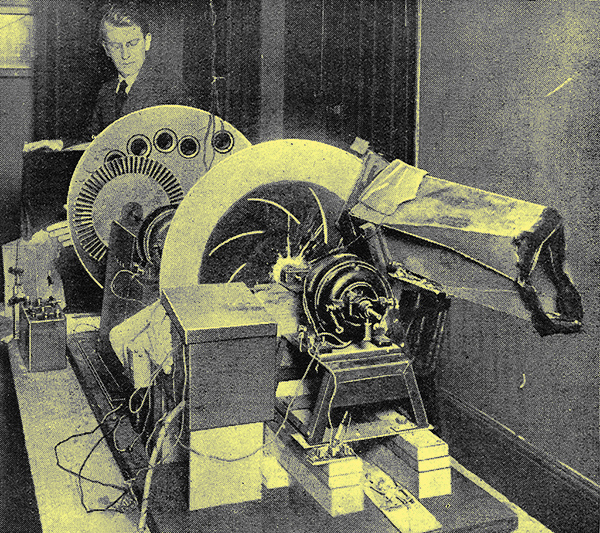
A photograph of Mr Baird with an experimental television equipment set up in his laboratory in the summer of 1925.
Reverting to the book analogy, it is plain that we may imagine the visible object as corresponding to a page containing a few lines of large type or many lines of small type, as consisting of lines extending over the whole page or divided into columns, reading normally from left to right or inverted from right to left, or running in a vertical direction upwards or downwards. We may go further and have alternate lines running in opposite directions or arrange the type in a spiral formation starting from the centre and spreading outwards. These arrangements are all representative of scanning systems which have been proposed and there are in all probability many others.
The point which has to be remembered as of fundamental importance is that in television there is no one way of scanning the object that can be regarded as normal. The visible subject matter has to be coded at the transmitter and decoded at the receiver and, beyond the obvious fact that the systems used for transmission and reception have to correspond to each other, there is not, prima facie, any reason why any one method of coding should be preferred to any other. There is, however, one important aspect and that is the degree of subdivision of the object, i.e., the number of so-called 'picture points.
If we take a concrete example in which scanning is, say, from left to right, we regard the picture as being made up of a succession of horizontal lines the thickness of which is just sufficient to fill the whole of the area which is being scanned. If the latter be taken as rectangular, the thickness of the lines will be equal to the height of the picture divided by the number of lines, and if we wish the detail of the picture in a horizontal direction to be of the same degree of perfection as that in a vertical direction we may imagine each line to be divided up into squares the sides of which are equal to the thickness of the lines. It is then just possible to transmit a pattern consisting of alternate black and white squares each of which is of the size of one 'picture point;, but no finer grained picture can be transmitted or reproduced.
The problem of television thus consists in settling, in the first place, what rate of repetition and degree of detail will give rise to a satisfactory picture, and, secondly, in devising apparatus for analysing and synthesising the image of the visible object which is being transmitted and received.
With regard to the first point, there is no doubt that the present Baird transmissions have provided an excellent starting point and, on the basis that one must learn to walk before one can run, have been amply justified. In the writer's view, however, in spite of the good results which have been obtained within the limitations of the system, the time has come when an increase must be made both in the number of picture points and in the rate of repetition of the picture. We thus arrive at the fundamental difficulty of organising a television service; no really basic improvement is possible unless the system of transmission is changed, all existing television receivers thus becoming obsolete.
Wavelength and Present Systems
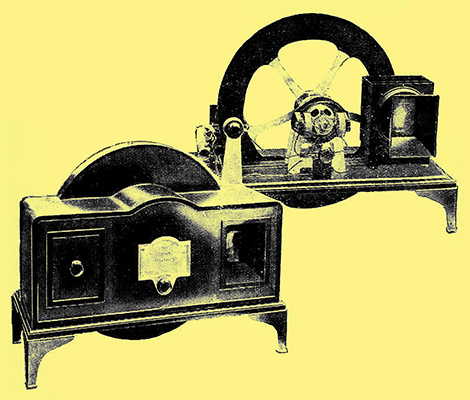
The Baird Televisor, the first television receiving set to be marketed for the reception of transmissions in this country. Inside view. The light source is an Osglim neon lamp.
However, there is one circumstance which is favourable to the present situation, and that is the fact that no material improvement to the existing television service is worth while if the medium wave broadcasting band is to be used for the radio link. With the present system of transmission it would be desirable to transmit modulation frequencies as high as 20 or 30 kHz, but, as is well known, a greater side-band width than 9,000 kHz on either side of the carrier is not possible in view of the congestion of the ether. It is therefore out of the question to increase the picture points unless a change of wavelength is made of such a character that the necessary side-band width can be accommodated, and there is no reason why the present system should not remain as a standard, at any rate until the possibilities of television in finer detail have been explored. Any future system may then comprise scanning apparatus giving a finer analysis of the picture and a radio link on a short wavelength where the required side-band width is alone available.
In considering the possibilities of improving radio transmitting conditions, attention has been focused mainly upon what are known as the ultra-short waves, i.e., those below 8 metres, mainly for reasons arising out of experience in connection with facsimile transmissions on the waves around 50 to 100 metres used for transcontinental traffic it is, of course, well known that the latter waves depend for their long-range qualities upon reflections from the Heaviside layer, which, while giving rise to no harmful effects on telegraphic and telephonic circuits, result in confusion of a greater or less degree when visual subject matter is transmitted. Trouble as a consequence of such 'echoes' has been experienced in the transmission of facsimile images at relatively low scanning speeds, and it appears to be generally considered that television on these wavelengths would be subject to far greater interference and would thus be impossible in practice.
Wavelength and Service Area
When we come to wavelengths below eight metres we arrive at conditions where reflections from the upper atmosphere do not take place. The result of such a state of affairs is that only a more limited area can be effectively served by one broadcasting station, since the waves attenuate very rapidly as the distance from the station increases, but, on the other hand, there is the advantage that 'echo' troubles entirely vanish. Very little information is available as to the problems of serving a given area with modulated ultra-short waves; there is strong evidence that the shadow-effects of buildings are inclined to be serious, but it does not appear that 'optical conditions' are strictly necessary, i.e., that the receiving aerial must be able to 'see' the transmitting aerial. On the other hand, reception is inclined to be 'patchy, and it seems fairly clear that the erection of ultra-short wave aerials in London will not be the simple business to which ordinary broadcast listeners are accustomed in connection with medium and long wavelengths.
The position in connection with improving the detail of the transmitted picture thus resolves itself into the provision (a) of an optical system which subdivides the picture into a greater number of elements, and (b) of an electrical system, including a radio link, which enables the improved detail to be effectively transmitted. The situation under the former heading necessitates a decision as to what degree of detail is essential to good entertainment value, a question which is comparable in one sense to the case of frequency band width in telephonic transmission, but in another sense stands in strong contrast to it. The decision in the case of telephony makes no difference to the design of receivers, as these can perfectly well ignore the extended frequency range if for any reason they do not want to take advantage of it; the decision in the case of television, however, is binding upon all parties, since the receiving apparatus must operate in synchronism with and in exact conformity to the transmitting apparatus.
Of these two problems the second does not require much further consideration, since the matter of the radio link is perfectly straightforward, though, paradoxically enough, it may prove the most serious stumbling block. We have to design a transmitter which operates on the ultra-short wavelengths, is capable of being modulated over a frequency range of anything up to 500 kHz with substantially uniform response, and has an aerial system which efficiently distributes the radiated power. On the receiving side an aerial has to be set up which is an efficient collector, having regard to its location, and the received high frequency waves have to be amplified uniformly over whatever range of frequencies is indicated. The most serious problems are field strength and interference, and it must be borne in mind, of course, that the larger the frequency hand being received the greater will be the susceptibility of the apparatus to interference, particularly from the ignition systems of motor cars. The purely technical side of building flat amplifiers does not offer insuperable difficulties, though, of course, an unusually large number of stages of amplification may be required.
Short Wave Interference
Having done all that is to be done in these respects, it is a matter of practical experience to discover whether ultra-short wave television broadcasting is or is not possible. The writer's feeling is that a serious campaign to induce motor car manufacturers to put suppressor resistances in their ignition systems will he a necessary prelude to any sort of satisfactory service, and the success of this campaign will be the main condition of success in the whole enterprise.
We now return to the consideration of the former of the two problems, and we are at once faced with the necessity for an important series of decisions which, it must be borne in mind, have to he made for the industry as a whole. We require to settle:-
- the number of times the picture is to be scanned per second;
- the shape of the picture and the manner in which scanning is to be carried out;
- the number of picture elements that are necessary for adequate detail.
According to the present Baird system the picture is scanned 12½ times per second in 30 vertical strips; the shape of the picture is seven (vertical) by three (horizontal), and the number of picture points consequently 2,100.
Service in Germany
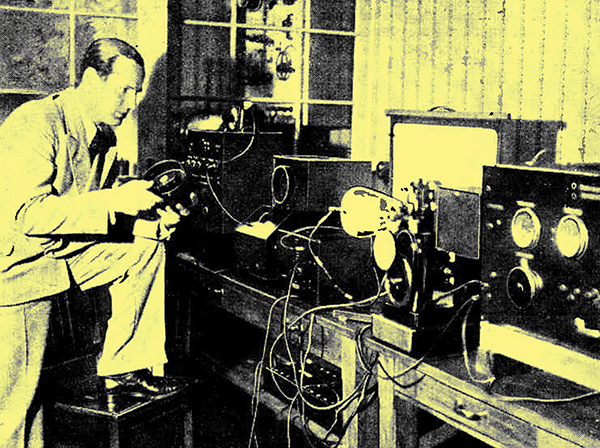
Baron Manfred von Ardenne, an early investigator of television in Germany, and a pioneer of the cathode ray system. In this recent picture he is seen with his latest apparatus employing what is known as the 'speed-modulation' system.
As a step in the direction of greater detail, the German Post Office has instituted a regular service of experimental ultra-short wave television transmissions from Witzleben in which the picture is horizontally scanned twenty-five times per second in ninety strips, the shape of the picture is five (vertical) by six (horizontal), and the number of picture points nearly 10,000.
It is advisable to examine more closely the steps by which the German authorities arrived at these figures. ln the first place, both the shape of the picture and its rate of repetition are in close conformity with the standards chosen for talking films and enable transmissions to be effected by means of a film provided with scanning machinery. The difference between the picture-frequency chosen and that of twenty-four per second has an important bearing upon the problem of synchronising, since it enables motors to be used at both transmitting and receiving ends which are synchronously driven by simple apparatus from the 50 Hz AC mains. Had the picture frequency of twenty-four per second, characteristic of talking pictures, been retained for television purposes it would have been necessary to employ an awkward train of gears if synchronisation were to be effected by means of the 50 Hz mains, and it has evidently been found of no detriment to the results obtained to increase the speed of a talking film in the ratio 25:24 when transmitting it for television purposes.
Apart from the talking film question, considerations of flicker indicate the desirability of an increase in the picture frequency from 12½ per second, unless the effect of persistence of vision can be aided by fluorescence, as in the case of the cathode ray tube, or by some similar effect. The prospect of improved operation along these lines cannot be dismissed, as it is possible to obtain better detail with a slow picture frequency, other things being equal, but the importance of talking film transmission would seem to indicate a higher picture frequency such as that chosen in Germany, in spite of the disadvantages which it may entail.
Synchronising and the Grid System
It is perhaps worth while to digress for a short space to consider the synchronising problem in greater detail. Synchronism between transmitter and receiver is an essential feature of any television system and the demands for it are in the highest degree exacting, since we must not only ensure that the picture is stationary, but also that it is correctly framed, i.e., not displaced out of its right position. The latter feature necessitates a consideration of the phase relationship between the two systems; the simplest explanation is again to be found in the book analogy, if we consider the transmitter to be looking at the first word in a line and the receiver to be pointing, say, at the middle of the same line. If the receiver is half a line ahead all the way it is clear that the left- and right-hand margins of the book page itself will appear adjacent to each other in the middle of the reproduced version at the receiver, and the original page will be divided down the middle, so that the two divisions appear on either side at the receiving end.
Many devices are known according to which the transmitter sends out a synchronising signal to hold the receiver in step with it, and all of them introduce an element of some complexity, since they require that this signal should be separated from those corresponding to the picture modulations. On the other hand, if both the transmitter and receiver are fed from the same alternating current network synchronism can be automatically established, subject to the existence of a phasing control which will restore any casual displacement of the picture from its correct position. It is uncertain whether all the alternating current networks in the Central electricity board's grid system will operate synchronously at all times, but at any rate there is a compelling argument in favour of close regulation owing to the very general use of electric clocks driven synchronously from the mains. Perhaps the slightly greater precision necessary for television purposes might he attained by the provision of a master frequency supply broadcast all over the country as a 50 Hz modulation of a radio wave and accurately controlled by a high quality tuning fork or astronomical clock. The frequency band required by this signal would be negligible, and it could be used for direct control of electric clocks or television apparatus, in places where no mains supply was available, and also for regulating the frequency of all sections of the grid system. It is, of course, unnecessary and undesirable to use an ultra-short wavelength for such a 'master wave'; the question as to what wave-length should be employed is an entirely open one and might be decided simply from the standpoint of what was available for use.
Standard of Detail
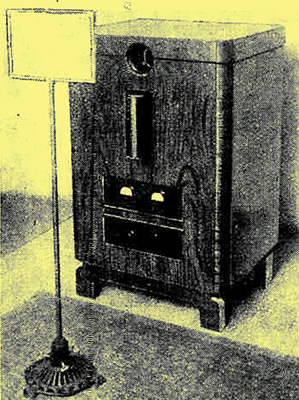
The Mihaly television receiver shown at the recent Radio Exhibition in Berlin. This system employs a stationary mirror drum, with a rotating reflecting mirror, and an external screen on which the picture is projected. The system was described in the issue of The Wireless World of September 15, 1933.
Returning to the consideration of the researches of the German Post Office, the main decision, namely, that of the degree of detail required, was arrived at experimentally by the production, using purely optical means, of a series of films having different numbers of picture points. Horizontal scanning was adopted, i.e., in terms of the book analogy, referred to earlier, exactly corresponding to an ordinary book. The number of lines was varied in the different films, and the graduation along the lines was made finer in detail as the number of lines was increased, the results being made to conform exactly with what would be obtained in a series of ideal television systems in which scanning was carried out in a manner corresponding to each film.
As would he expected, an improvement in the picture detail was obtained which was very marked as the number of lines was increased from 30 upwards, but which became less effective after a certain standard of detail had been achieved. The conclusion was that 90 lines and 10,000 picture points represented a degree of detail which was sufficient for practical purposes, and that a closer analysis only gave a 'diminishing return' by way of improvement.
One System or Many?
From the standpoint of television in this country we have now to consider the question as to whether any standardisation of television transmissions is possible, and, if so, what the nature of the transmissions should be. It is obvious that standardisation is desirable; indeed, it is almost impossible to imagine the alternative situation, where the BBC puts into operation, either in succession or even simultaneously, systems of transmission of a proprietary character designed expressly to work in conjunction with receivers of specific origin. The matter would seem to be one in regard to which the BBC should take great care, since, setting aside the danger of the commercial advantage passing into one set of interests, it is too early to say yet on what lines the future development of television will lie, and it would benefit neither the public nor the industry if a premium were prematurely put upon any one of the many methods of operation that have been advocated.
The alternative to the BBC acting as the only source of transmissions would be for experimental television transmitting licences to be granted by the Postmaster-General to various commercial companies developing television and to amateur experimenters so that the relative merits of a number of schemes could be tried out in practice before the BBC was committed to a service.
There is no doubt that the inauguration of a television broadcasting service on short wavelengths, with increased detail in whatever measure is considered desirable, would cause an enormous awakening of interest in the whole subject and might, in fact, mark the starting point of industrial developments of the greatest importance. ln this situation we look to the Corporation to take the broadest possible view and, in the light of experience in Germany and elsewhere, and if it sets up, under its own auspices, a system of transmission it should be one which will allow the fullest possible scope to the endeavours of all sections of the industry. In particular, whatever else is decided, the question of synchronisation should be settled on a basis which is operative for any type of receiver, and in such a manner as to permit the use, wherever possible, of the 50 Hz controlled-frequency mains for synchronous operation.
|